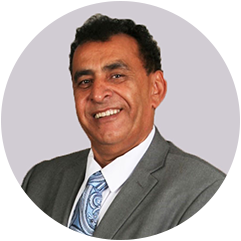Webpage

Balancing Act: Traversing Healthcare Data Privacy for Personalized Solutions
Harvard University epidemiologist Andrew Beam investigated the potential of Large Language Models (LLM) chatbots in reshaping doctor-AI collaboration and diagnostic accuracy. The study found that the LLM achieved an 88 percent accuracy rate in providing the correct diagnosis among its top three choices. While physicians demonstrated a slightly higher accuracy at 96 percent, the LLM outperformed individuals without medical training, who achieved a 54 percent accuracy rate.
It's crucial to recognize the growing importance of AI in healthcare. The industry has seen an unprecedented surge in data generation, transforming how medical professionals deliver care and make decisions. This influx highlights both challenges and opportunities, underscoring the need for a nuanced understanding of the evolving healthcare data landscape. But what is the far side of the moon when it comes to healthcare data?
Balancing Data Collection and Ensuring Privacy
Amidst the increasing data deluge, a delicate balance emerges between the imperative to leverage information for improved patient outcomes and the critical need to maintain the utmost privacy and confidentiality. As healthcare organizations harness the power of data analytics, artificial intelligence, and other cutting-edge technologies, the ethical and legal considerations surrounding patient privacy come to the forefront. Striking the proper equilibrium between data processing efficiency and robust privacy measures becomes a central theme in our exploration, highlighting the challenges and strategies in navigating this intricate landscape.
Processing Copious Amounts of Data
This influx of information, while presenting challenges, also offers unprecedented opportunities for advancing patient care, medical research, and operational efficiency. The challenges lie in efficiently managing, processing, and securing these vast datasets, ensuring that healthcare professionals can harness the wealth of information while navigating complexities such as interoperability, data standardization, and ethical considerations.
Approximately 30% of the world's data volume is being generated by the healthcare industry and is expected to increase to 36% by 2025 (RBC). Managing this sheer volume of data, controlling costs, and delivering personalized healthcare necessitates the intervention of modern technologies like generative AI. In fact, a data brief by HealthIT cited that over 90% of physicians who use telemedicine platform services felt that they offered comparable quality to in-person consultations, contributing to the anticipated increase in global generative AI software spend on health and healthcare tools to $20 billion by 2030.
In the past decade alone, the proliferation of electronic health records (EHRs), medical imaging, and wearable health devices has contributed to an astronomical surge in data creation.
Legislative Protection Around Data Privacy
The legislative framework around data privacy comprises a multifaceted structure, including state and federal regulations. These legislations, along with others, establish a robust foundation, outlining the rights of individuals, the responsibilities of organizations, and the consequences for non-compliance. Let's look at some of them:
HIPAA:
The Health Insurance Portability and Accountability Act (HIPAA), enacted in 1996, is a foundational piece of legislation designed to safeguard the privacy and security of individuals' health information. HIPAA establishes national standards for the protection of sensitive health data, ensuring its confidentiality and integrity. Covered entities, including healthcare providers and insurers, must adhere to HIPAA regulations to maintain the trust and privacy of patients' personal health information.
Knox-Keene Health Care Service Plan Act of 1975:
Enacted in 1975, the Knox-Keene Health Care Service Plan Act is a pivotal piece of legislation shaping managed healthcare in California. This act establishes the regulatory foundation for healthcare service plans, emphasizing comprehensive quality standards, accessibility, and the fair provision of health services.
California Title 22:
California Title 22 stands as a comprehensive set of regulations governing health facilities in the state. From licensing requirements to detailed standards for patient care, this regulatory framework covers a wide range of aspects and ensures the highest quality of healthcare services.
HITECH Act:
The Health Information Technology for Economic and Clinical Health (HITECH) Act incentivizes the adoption and meaningful use of electronic health records (EHRs) to enhance the efficiency and security of health information exchange. This act has been instrumental in propelling the healthcare sector toward greater technological integration and interoperability.
21st Century Cures Act:
Enacted in 2016, the 21st Century Cures Act is a landmark legislation focused on advancing medical innovation, modernizing the regulatory environment, and promoting patient access to healthcare data.
HITRUST CSF Framework:
The HITRUST CSF (Common Security Framework) is a comprehensive cybersecurity framework explicitly tailored for the healthcare industry. Developed to address the evolving landscape of health information protection, HITRUST CSF provides a standardized approach to managing and securing sensitive healthcare data.
Adhering to Regulatory Requirements
Digital transformation brings about new business models, operational processes, and ways of interacting with customers and stakeholders. As a result, governance structures and practices must be reevaluated and updated to ensure they remain relevant and effective.
Here are some ways that can help healthcare businesses and healthcare software providers deliver the most personalized healthcare experiences without overriding regulatory compliances:
Ensuring Compliance
In the intricate landscape of healthcare regulatory compliance, establishing a comprehensive strategy is paramount to safeguarding sensitive data and ensuring regulatory adherence. One pivotal aspect is the implementation of thorough awareness and training programs, emphasizing the proper utilization of technology. This extends beyond traditional staff, encompassing Full-Time Employees (FTEs), contingent workers, and the broader partner ecosystem. A robust set of policies, procedures, and tools should be in place for compliance and to foster good business practices across all facets of your organization.
Implementing Measures for Data Security
Ensuring healthcare data security involves implementing a formidable program across all devices. This includes leveraging the latest encryption and security tools within your infrastructure, services, network, and all devices – including managed mobile devices containing protected data. To fortify your defense against evolving threats, establish a security ecosystem that seamlessly integrates policies, Standard Operating Procedures (SOPs), technology, and log analytics. This synergy creates a foundation for continuous process improvement in security, ensuring access and data protection are ingrained in day-to-day operational processes.
Data Anonymization and De-identification
Employing advanced techniques such as cryptographic hashing, differential privacy, and tokenization can transform sensitive information into anonymous, non-identifiable data while retaining its utility for analysis. On the other hand, anonymization methodologies go beyond simply removing direct identifiers, focusing on preventing re-identification through the careful masking of unique patterns. Additionally, adopting strict access controls, employing data encryption, and conducting thorough risk assessments contribute to a comprehensive approach, ensuring that the data is not only anonymized but also protected from potential privacy breaches.
Ensuring Patient Consent and Transparency
Respecting individual autonomy and obtaining informed consent is a pivotal step in personalized healthcare, allowing patients to make well-informed decisions about their participation. Transparency further strengthens the patient-provider relationship by providing clear information about the purposes, potential risks, and benefits associated with personalized initiatives.
Conclusion
In the pursuit of tailoring healthcare solutions to the unique needs of each patient, a delicate equilibrium must be struck with the rigorous demands of privacy regulations. Precision in healthcare requires a meticulous approach that seamlessly integrates personalization with a steadfast commitment to privacy. This integration allows healthcare providers to deliver individualized solutions, empowering patients on their healthcare journey while upholding the utmost standards of confidentiality and ethical care. It is this dual commitment to personalization and privacy that serves as the foundational pillar of a patient-centric healthcare paradigm, navigating the ever-evolving regulatory landscape in the pursuit of better, more personalized patient care.
To learn how Intelliswift can help you navigate these challenges, visit here.

Hassan Sharif, SVP, Healthcare Solutions
Hassan Sharif, a seasoned leader with 25+ years in global healthcare roles, specializes in data security and risk management. His expertise in data management, governance, enterprise architecture, and analytics, along with a strong foundation in software engineering, has driven multi-million-dollar savings in operational and IT costs for various businesses.


